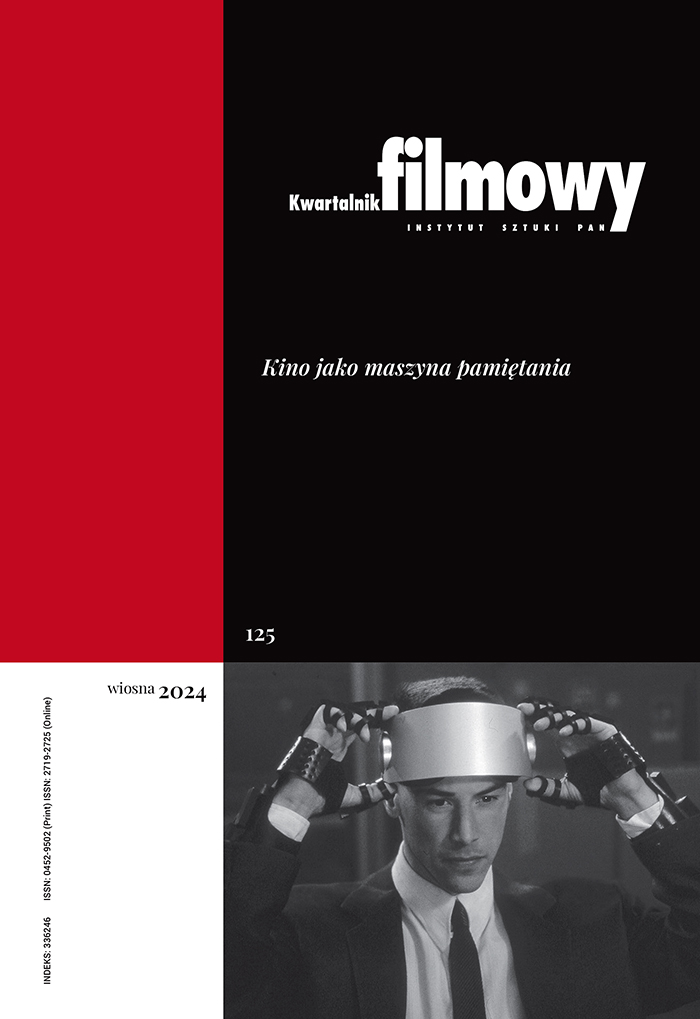Cinema of Reversed Time
Abstract
“Cinema of reversed time” that is how one could call a group of films, where the technique of détournement is used. Détournement (turning around of images) of art, including films, was already practiced in film soon after the Second World War. For example kung-fu films were given new, revolutionary dialogues by the representatives of Lettrism. A good example of a film employing the technique of detournement is the cartoon by Lorelei Pepi Happy & Gay (2009), made in the style of early animated talkies, but with gay and lesbian characters. Two other good examples of playing with the conventions of old films are Saddest Music in the World and Cowards Bend the Knee (both from 2003), in which styles and genres are mixed, and once forbidden contents introduced. Detournement is sometimes also practiced by film makers associated with the found footage movement. In particular the work of Martin Arnold, in which he uses single frames from Hollywood films, deserves a mention.
Keywords:
Lorelei Pepi, Guy Maddin, Martin ArnoldReferences
Anger Kenneth, Hollywood Babylon, Straight Arrow Books, New York 1975, s. 67.
Google Scholar
MacDonald Scott, Martin Arnold, w: tenże, A Critical Cinema: Interviews with Independent Filmmakers, University of California Press, Berkeley 1998.
DOI: https://doi.org/10.1525/9780520919389
Google Scholar
Maddin Guy, From the Atelier Tovar: Selected Writings, Coach House Books, Toronto 2003, s. 86.
Google Scholar
Miessgang Thomas, Beyond the Words: The Multiple Narratives of the Filmmaker Martin Arnold, w: M. Arnold, Deanimated, red. G. Matt, T. Miessgang, Springer, Wien – New York 2002, s. 16.
Google Scholar
Mikurda Kuba, Michał Oleszczyk, Kino wykolejone. Rozmowy z Guyem Maddinem, Korporacja Ha!art, Kraków 2009, s. 53, 74-75, 167.
Google Scholar
Authors
Marcin Giżyckikwartalnik.filmowy@ispan.pl
Rhode Island School of Design United States
Dr hab. Krytyk i historyk sztuki, autor książek z dziedziny historii filmu i zjawisk kultury artystycznej. Wykładowca w Rhode Island School of Design w USA. Opublikował m.in. Nie tylko Disney — rzecz o kinie animowanym (2000), Koniec i co dalej? (2001), Słownik kierunków, ruchów i kluczowychpojec sztuki drugiej połowy XX wieku (2002), Wenders do domu! Europejskie filmy o Ameryce i ich recepcja w Stanach Zjednoczonych (2006).
Statistics
Abstract views: 1036PDF downloads: 134
License
Copyright (c) 2009 Marcin Giżycki

This work is licensed under a Creative Commons Attribution 4.0 International License.
The author grants the publisher a royalty-free non-exclusive licence (CC BY 4.0) to use the article in Kwartalnik Filmowy, retains full copyright, and agrees to identify the work as first having been published in Kwartalnik Filmowy should it be published or used again (download licence agreement). The journal is published under the CC BY 4.0 licence. By submitting an article, the author agrees to make it available under this licence.
In issues from 105-106 (2019) to 119 (2022) all articles were published under the CC BY-NC-ND 4.0 licence. During this period the authors granted a royalty-free non-exclusive licence (CC BY-ND 4.0) to use their article in „Kwartalnik Filmowy”, retained full copyright, and agreed to identify the work as first having been published in our journal should it be published or used again.
Most read articles by the same author(s)
- Marcin Giżycki, Smartphone – The Triumph of Eisenstein , Kwartalnik Filmowy: No. 112 (2020): Polish Documentary, Polish Animation
- Marcin Giżycki, … Only Stills Remained: Nonexistent Films of Cindy Sherman , Kwartalnik Filmowy: No. 115 (2021): Form Film, Content Film
- Marcin Giżycki, „L’âge d’or” – the Masterpiece of Provocation , Kwartalnik Filmowy: No. 109 (2020): Architectural Space in Film
- Marcin Giżycki, The Last Wizard of Western World , Kwartalnik Filmowy: No. 34 (2001): Cinema at the Turn of the Century
- Marcin Giżycki, Why I Do Not Like Advertising in the Cinema , Kwartalnik Filmowy: No. 105-106 (2019): Cinema and Political Transformation
- Marcin Giżycki, Expanded Cinema Thirty Years Later , Kwartalnik Filmowy: No. 35-36 (2001): Cinema and New Media
- Marcin Giżycki, The Highs and Lows of Animation in Bohemia , Kwartalnik Filmowy: No. 81 (2013): Child in Film
- Marcin Giżycki, The Magical Beginnings of Cinema , Kwartalnik Filmowy: No. 74 (2011): Film Objects
- Marcin Giżycki, The Revenge of Joker and Parasites , Kwartalnik Filmowy: No. 108 (2019): Film Production and Distribution
- Marcin Giżycki, The Artist in a Haunted House: Jeremy Blake and the Winchester Mystery House , Kwartalnik Filmowy: No. 97-98 (2017): Wandering Motifs











